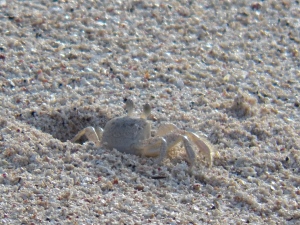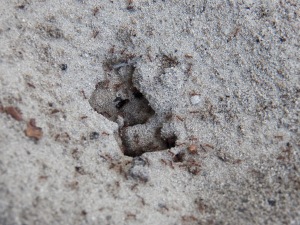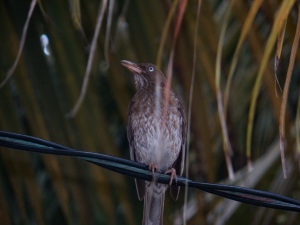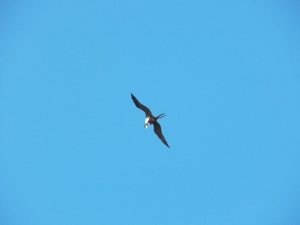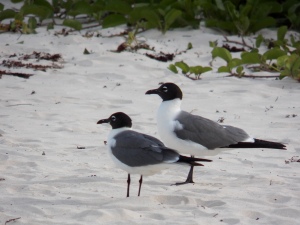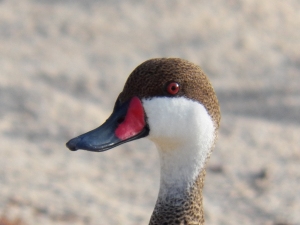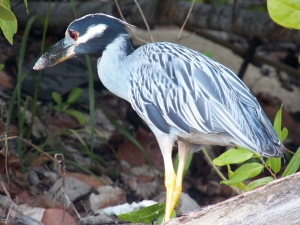Fauna of Puerto Rico: Part 4 (Culebra)
I’m going to preface this post by saying that I didn’t have my camera available for a lot of the cool stuff I saw on Culebra, so I’m only going to post about the things for which I have pictures. If I get a picture of them, I’ll post about them down the line. Things to look forward to in another post (perhaps): Brown Pelican, Common Ground Dove, Zenaida Dove, House Sparrow and Rock Pigeon (if I get desperate).
Ghost Crabs, Ocypode spp., Ocypodidae, Decapoda
These crabs are common denizens of beaches. They live in small burrows in the sand and are most active at night. They are omnivorous, eating anything from clams to beach debris. We had one living in our campsite that I watched excavate its burrow around 1 in the morning. The males have one claw that is larger than the other. The one in this picture was out on the beach next to the campsite.
Fire Ants, Solenopsis spp., Formicidae, Hymenoptera
There were several large anthills (about a foot in diameter) around the campground. They were easy enough to avoid if you were looking, but I mistakenly stepped too near one or two of them and was immediately bitten several times on my feet and ankles. The bites of these fire ants are relatively bothersome and sting a good bit. They are highly territorial and feed on anything they can find. They are just a fact of life in the tropics and will be happy to finish up any food you drop on the ground.
Pearly-eyed Thrasher, Margarops fuscatus, Mimidae, Passeriformes
These birds are fairly common all over Puerto Rico. I have seen them at the field station and saw plenty on Culebra. They are good-sized (comparable to a robin) omnivores and have a varied song like mockingbirds in the same family Mimidae.
Black-faced Grassquit, Tiaris bicolor, Thraupidae, Passeriformes
These dull-colored birds flew through the brush outside our campsite, so I got a picture and came back to the internet to ID them. Grassquits are herbivorous, feeding on seeds. They are small birds that are common throughout the Caribbean.
Magnificent Frigatebird, Fregata magnificens, Fregatidae, Pelecaniformes
Despite my many attempts, I could not get a very clear picture of a frigatebird. They were constantly high up and moving quickly, once even getting mobbed my a bunch of small birds over the beach. I saw easily half a dozen of them.
Frigatebirds are distinctive seabirds with a long tail and thin, sharp wings. The males have a red gular sac on the neck. They feed on sea creatures, especially fish, without ever entering the water. Unlike most birds, frigatebirds don’t produce much oil to keep their feathers waterproof. As such, much of their life is spent aloft, soaring on thermals and snatching fish from the water surface. They are known kleptoparasites, meaning that they will steal food from other seabirds.
Laughing Gull, Leucophaeus atricilla, Laridae, Charadriiformes
The laughing gull is the most common gull in Puerto Rico and Culebra. They are entirely black, white, and gray, except for a bit of red on the bill. They have black heads and black feet, as well as dark tails and wings. Like all gulls, they are omnivorous, feeding on anything they can find along the shore from beached fish and crabs, to camping leftovers.
White-Cheeked Pintail, Anas bahamensis, Anatidae, Anseriformes
These ducks have a spotted brown body, solid brown head, white cheek, as well as a red and blue bill. The are dabbling ducks, feeding on aquatic plants and small creatures just under the water surface. I saw several of them flying over the bay as well as these two which were on the beach.
Here’s a better look at the red and blue bill. They also have a red eye that stares deep into your soul.
Yellow-Crowned Night Heron, Nyctanassa violacea, Ardeidae, Pelicaniformes
There was at least one of these that kept coming back and walking along the dunes past our campsite. Like all herons, night herons are typically sit-and-wait predators, standing in the shallows waiting to quickly spear small fish or crustaceans unfortunate enough to come past. They are primarily nocturnal, though I had no problem finding this one during the day.
